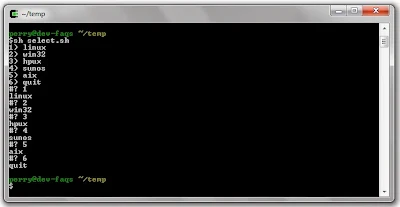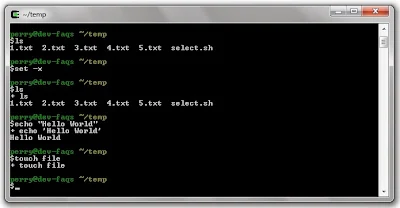From the bash manual, the following environment variables control the display of prompt in a Cygwin or Linux terminal namely PS1, PS2, PS3, PS4.
Note: For referring the bash manual type info bash
Key Points
1. PS1 : The value of this parameter is expanded and used as the primary prompt string. It's default value is'\s-\v\$ '
2. PS2 : The value of this parameter is expanded as with PS1 and used as the secondary prompt string. The default value is>
3. PS3 : The value of this variable is used as the prompt for select command. If this variable is not set, select command prompts with#?
4. PS4 : The prompt is used when you have tracing enabled for debugging the bash scripts. The PS4 value is printed each time the command is echoed on the screen. The default value is+
a) PS1 demo
1. Identify the current prompt setting in your Cygwin/Linux terminal by typing
echo $PS12. Make the modifications to
PS1 and export the new PS1 variable. Your prompt should change immediately
b) PS2 demo
When executing interactively, bash displays the primary prompt
PS1 when it is ready to read a command, and the secondary prompt PS2 whenit needs more input to complete a command.

c) PS3 demo
This prompts user to provide an input.
#!/bin/bash LINUX=linux WIN32=win32 HPUX=hpux SUNOS=sunos AIX=aix QUIT=quit OPTIONS="\ $LINUX \ $WIN32 \ $HPUX \ $SUNOS \ $AIX \ $QUIT" select option in $OPTIONS; do echo "${option}" if [ "${option}" = "quit" ]; then exit fi doneOutput:

d) PS4 demo
Enable tracing by typing the following command
set -x
Bash allows these prompt strings to be customized by inserting a number of backslash-escaped special characters that are decoded as follows:
\a an ASCII bell character (07)
\d the date in "Weekday Month Date" format (e.g., "Tue May 26")
\D{format}
the format is passed to strftime(3) and the result is inserted into the prompt string; an empty format results in a locale-specific time representation. The braces are required
\e an ASCII escape character (033)
\h the hostname up to the first `.'
\H the hostname
\j the number of jobs currently managed by the shell
\l the basename of the shell's terminal device name
\n newline
\r carriage return
\s the name of the shell, the basename of $0 (the portion following the final slash)
\t the current time in 24-hour HH:MM:SS format
\T the current time in 12-hour HH:MM:SS format
\@ the current time in 12-hour am/pm format
\A the current time in 24-hour HH:MM format
\u the username of the current user
\v the version of bash (e.g., 2.00)
\V the release of bash, version + patch level (e.g., 2.00.0)
\w the current working directory, with $HOME abbreviated with a tilde
\W the basename of the current working directory, with $HOME abbreviated with a tilde
\! the history number of this command
\# the command number of this command
\$ if the effective UID is 0, a #, otherwise a $
\nnn the character corresponding to the octal number nnn
\\ a backslash
\[ begin a sequence of non-printing characters, which could be used to embed a terminal control sequence into the prompt
\] end a sequence of non-printing characters
References:
1. bash manual


No comments :
Post a Comment